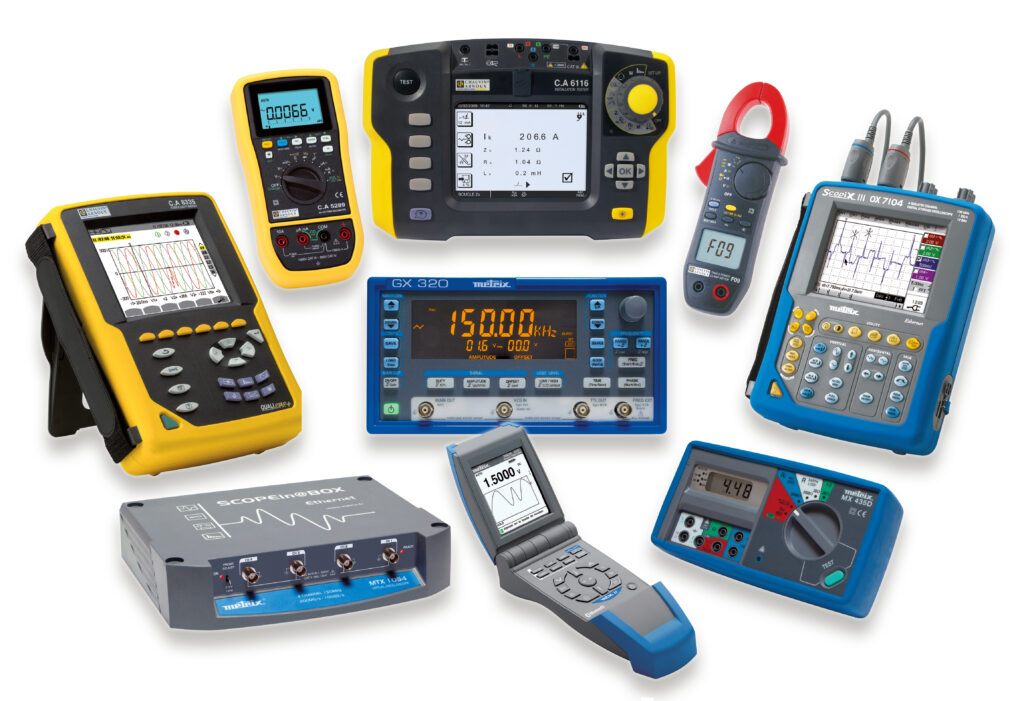Every factory or plant relies on accuracy. Workers need the right tools to measure, inspect, and fine-tune machines. Without proper gear, mistakes slip through and safety breaks down. This is where test and measurement equipment makes a big difference.

The tools we explore here help technicians catch errors, reduce risks, and boost productivity. Whether someone inspects power lines, maintains pumps, or adjusts pressure, the right gear keeps everything running smoothly.
1. Digital Multimeter
Technicians reach for this first. It measures voltage, current, and resistance. Many workers use it when they check power systems or machines. Strong builds and clear displays make it a must.
Multimeters spot problems early. They also help teams compare readings before and after repairs. This sharpens safety and speeds up work.
2. Infrared Thermometer
This tool helps teams read temperatures from a distance. Workers point it at motors or pipes and pull the trigger. The screen shows the heat level in seconds.
It helps catch overheating parts before they break. This avoids downtime. It also lets workers scan moving parts without getting too close.
3. Clamp Meter
Clamp meters grab wires and read electric current. You don’t cut power or touch metal. Just open the clamp, clip it around the cable, and check the screen.
This tool works well in tight spaces or live systems. It lets you measure safely, even while machines run.
4. Torque Adjustable Wrench
When bolts need a specific force, this tool steps in. It lets workers twist with control. Turn too hard, and you damage parts. Turn too soft, and they loosen.
The torque adjustable wrench helps workers grip with just the right strength. Many mechanics and engineers trust it to hold structures together without over-tightening.
5. Sound Level Meter
In loud factories, workers must watch noise levels. This tool reads how loud machines grow. High sounds damage ears, so teams use these meters to stay safe.
The meter shows numbers in decibels. It also helps managers plan noise zones and set quiet rules.
6. Pressure Gauge
Pipes and tanks hold gas or liquid under pressure. A sudden rise or drop can mean trouble. Pressure gauges show the current pressure and let workers spot leaks or blockages.
Workers use them in oil plants, water systems, and factories. Gauges help teams find faults fast and fix them before damage spreads.
7. Ultrasonic Leak Detector
Air leaks waste money and slow machines. This tool “listens” for leaks using sound waves. Even tiny holes make high-pitched noise, and this tool catches it.
Teams scan pipes or tanks with the sensor. They follow the sound until they find the hole. This saves time and resources.
8. Valve Wheel Wrench
Large valves open with heavy wheels. Turning them by hand strains arms and backs. The valve wheel wrench grips the wheel and gives workers extra power to turn it easily.
These wrenches stop injury and reduce time. They work best in water treatment, oil rigs, or chemical plants.
9. Laser Distance Meter
This device shoots a beam and measures how far it travels. It helps workers measure height, width, or depth with speed and care.
It works well in storage areas or large factories. Just point, click, and get an instant number. It removes guesswork and saves effort.
10. Vibration Tester
Machines often shake before they fail. This tool measures how much and how fast they vibrate. It warns teams before serious trouble strikes.
Vibration testers help prevent breakdowns. They keep systems balanced and parts working well.
How Each Tool Supports Industrial Work
| Tool | What It Measures / Helps With | Where It Works Best |
| Digital Multimeter | Voltage, current, resistance | Electrical systems |
| Infrared Thermometer | Surface temperature | Motors, pipes |
| Clamp Meter | Electric current in cables | Live circuits, tight spots |
| Torque Adjustable Wrench | Twist control on bolts | Machines, panels, frames |
| Sound Level Meter | Noise in decibels | Loud work zones |
| Pressure Gauge | Air or fluid pressure | Tanks, pipelines |
| Leak Detector | Tiny holes and leaks | Gas lines, compressed air systems |
| Valve Wheel Wrench | Opens stuck or heavy valve wheels | Industrial valves and pipes |
| Laser Distance Meter | Height, width, and distance | Warehouses, structures |
| Vibration Tester | Machine shaking and imbalance | Engines, pumps, motors |
Let’s break it down further:
This chart shows how each tool brings something vital to daily work.
Why These Tools Matter
Accuracy Builds Safety
When workers know exact numbers, they avoid errors. They stop faults early and protect others. Tools like the torque adjustable wrench keep things tight and secure. Others, like the valve wheel wrench prevent strain and slips.
Time and Money Stay in Control
Fast checks and early fixes reduce delay. The more tools teams use on their own, the less time teams waste. A good test and measurement equipment set improves work speed without cutting corners.
How to Choose the Right Gear
Before you buy or borrow gear, think about:
- What do you measure often?
- Do your tools break too soon?
- Do you need readings from far away?
- Are your tools easy to carry and read?
Smart teams match their gear to the jobs they do each day.
Use and Care Tips
- Keep tools clean and dry.
- Calibrate meters often.
- Check battery power weekly.
- Store in cases to prevent damage.
Careless storage shortens tool life. Good habits stretch every dollar further.
Looking Ahead
Industries grow and change. Machines get smarter. But workers still need hands-on tools that give fast, true answers. The best test and measurement equipment blends speed with safety and control.
Workers who use a valve wheel wrench avoid pain. Teams with a torque adjustable wrench stop bolts from snapping. With tools like these, factories stay safe and efficient.
Conclusion
The right tools shape good work. They help teams do their jobs better, faster, and with less risk. When the right equipment is in place, not only does the quality of work improve, but so does employee morale and workplace safety. If your workplace runs without these top ten tools, it might be time for a change. Investing in the right tools ensures long-term efficiency and safety, minimising the likelihood of costly errors or delays.
Measure better. Fix faster. Stay safe. Make sure your team has the tools they need to succeed and thrive.


